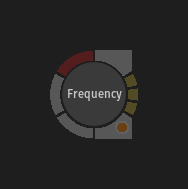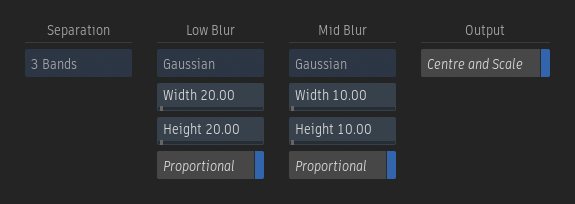Frequency
Use the Frequency node to separate a clip into multiple bands and simplify your compositing tasks.

| Access | To access the Frequency menu, use:
|
| Input | Front - The clip to separate into multiple bands. |
| Outputs |
|
The Frequency node only supports rendering in 16-bit fp and 32-bit fp, meaning that 8-bit, 10-bit, and 12-bit inputs are automatically converted to 16-bit using an adaptor. This is required as negative values can be output when Centre and Scale is disabled.
Workflow
Separating an image into frequency bands allows you to isolate and modify details. You can then composite the high and mid frequency passes with the low frequency pass to obtain a modified version of your original clip. This technique is useful to modify the fine details of an image while preserving the overall colour under these details.
For example, you can paint out the imperfections from a face using the high frequency pass and then composite it back with the low frequency.
It is also possible to use only one frequency pass and composite it with a clip different than the low frequency pass. Compositing a high frequency pass over the front clip connected to the Frequency node will sharpen the image.
Settings

Separation
Separation Mode
Select whether the Front image is separated in 2 or 3 bands.
When 2 Bands is selected, the image is split into two frequency bands: Low Frequency and High Frequency. The colours removed from the Low band are moved to the High Frequency output.
When 3 Bands is selected, the image is split into three frequency bands: Low Frequency, Mid Frequency, and High Frequency. The colours removed from the Low band are moved to the Mid Frequency output. The colours removed from the Mid band are moved to the High Frequency output.
Low Blur
Low Blur option
Select whether the separation is performed using a Gaussian or Box blur.
Width field
Sets the width of the Low Blur.
Height field
Sets the height of the Low Blur.
Proportional
Enable to affect the width and height proportionally.
Mid Blur
Mid Blur option
Select whether the separation is performed using a Gaussian or Box blur.
Width field
Sets the width of the Mid Blur.
Height field
Sets the height of the Mid Blur.
Proportional
Enable to affect the width and height proportionally.
Output
Centre and Scale
Enable to scale pixel values by half and centre them around middle grey (0.5) rather than black (0.0). When enabled, the modified high frequency and low frequency outputs must be composited back together using the Flame or Photoshop Linear Light blending mode. When disabled, they must be composited back together with the Flame Add blending mode.
The Flame Linear Light blending mode achieves the same blending operation as the Photoshop Linear Light one, but without clamping pixel values.
